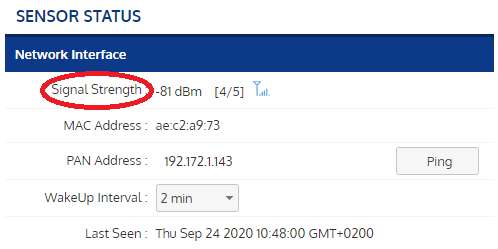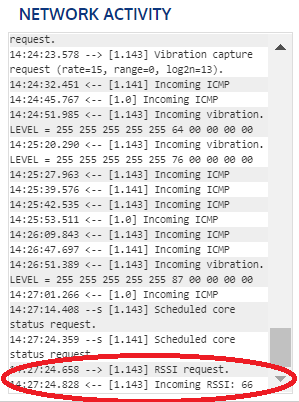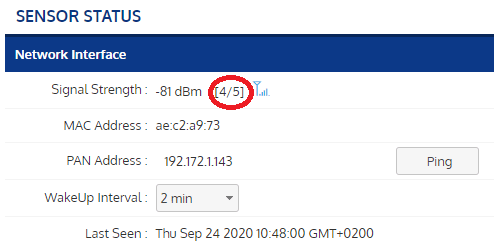1. General information
RSSI stands for Received Signal Strength Indicator. It is a measure of the wireless signal strength between the sensor and the Base Station (“Signal Strength” value in the iQunet Sensor Dashboard).

Remark: if there is a Repeater located between the sensor and the Base Station and the sensor sends its data via this Repeater to the Base Station (and not directly), then the RSSI value of the sensor is the signal strength between the sensor and the Repeater.
Remark: the RSSI value of the Base Station depends on which device has been active most recently. It shows the RSSI value of the sensor or Repeater that sent the most recent data packet to the Base Station. The RSSI value of the Base Station can thus contain wide variations and cannot be used for the evaluation of the signal strength of the sensors or Repeaters.
Remark: the iQunet RSSI values are not related to the RSSI values used for Wi-Fi.
2. Technical background
The “Signal Strength” value in the iQunet Sensor Dashboard is based on the rssival byte received from the sub-GHz transceiver used in the iQunet sensors (see figure below). This value is then converted to dBm units using the following formula: rssi_dBm = round(float(rssival)-140)*4.0/7.0 – 40 covering a range of approximately -100 to -30 dBm.

3. Updating of the RSSI value
The RSSI value in the Sensor Dashboard is triggered to update when you click on a device in the “Connected Devices” list at the left side and the according sensor status panel is drawn. The RSSI value is also updated automatically every 15 minutes.

You can see the RSSI requests in the network activity pane at the left (see figure below).

4. RSSI scores in the Sensor Dashboard
In the iQunet Sensor Dashboard you can find an indication of how good the signal strength between the device and the Base Station is. This signal strength is expressed as a score on 5.

The table below shows which RSSI values (in dBm) correspond to which RSSI scores in the Sensor Dashboard.
| RSSI value |
RSSI score |
| < -102 dBm |
0/5 |
| < – 97 dBm |
1/5 |
| < -91 dBm |
2/5 |
| < -85 dBm |
3/5 |
| < -80 dBm |
4/5 |
| >= -80 dBm |
5/5 |
5. Meaning of the RSSI value
Measurements can be successfully transmitted at RSSI values up to -102 dBm. Wireless radio communication can however be (temporarily) affected by various external factors (like for example EMI, other data traffic on the ISM channel from other sources, …). If parts of the measurement are lost due to these external interferences, the sensor will only retransmit these missing data packages (and not the complete measurement) until the data transfer is complete. In this way the sensor saves battery power and reduces its airtime to a minimum. The detected lost packages will be retransmitted up to 5 times. If the data transmission is still not successful after these 5 attempts, the complete measurement in the sensor will nevertheless be deleted and the wireless channel will be freed for upcoming new measurements from the same sensor or from other sensors. In this way a very robust communication and data transfer system is set up.
For battery-powered sensors it is however advisable to avoid RSSI values lower than -97 dBm and to aim for the highest possible RSSI value in order to avoid data packet losses by interferences and to extend the battery lifetime as much as possible.